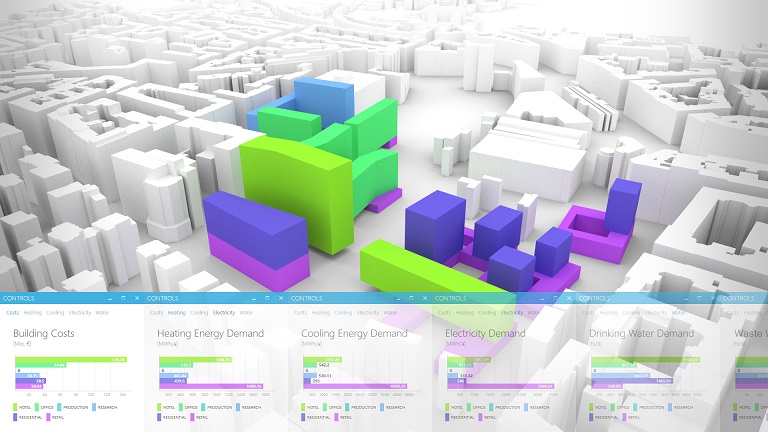
Cities, SI Urban 2/2020
Cable Car & digital urban planning
Since the mid-20th century, continuous social change and a constant rise in digital development and usage have been observed. Society today is living in an age of digital revolution, with profound changes in personal life and particularly in business life. As such, there are increasing demands e.g. on engineering and consulting companies to present their customers with ideas and solutions, plans and implementation as quickly as possible and with adaptability at short notice – especially in urban cable car project.
Big Data & computational design
To meet these expectations, new technologies are used for example to process and evaluate huge volumes of data (“big data”) with which statistical investigations and available figures can be used more efficiently for a broad variety of calculations. Project planning is also no longer conceivable without the subject of computational design.
In combination with defined parameters, existing structures can be extended with planned components and adapted or developed further by means of calculation algorithms. As such, engineering company ILF Consulting Engineers Austria GmbH (ILF) successfully uses special software tools for computer and data-driven planning and project development in urban development projects.
Many of these tools contribute substantially to the creation of sound bases for decision-making and argumentation in the early stages of urban development projects. At the same time, especially among clients, awareness and understanding of new technologies in urban planning and therefore also expectations and demands on project developers and planners are increasing.
One common challenge in connection with urban development projects lies in the formulation of innovative solutions to complex infrastructure problems as a result of growing mobility. In efforts to deliver sustainable solutions, urban cable cars are becoming increasingly significant, as ILF knows from experience.
Digitalisation plays a key role in the development and planning of urban cable car projects. Thanks to the new possibilities, it is easier to evaluate and present positive changes to a cable car project in the urban setting, whether by determining flows of people by means of mobile network data or with the use of automated methods (computational design) for optimal route planning.
3D models make ideas tangible
Working in 3D models in conjunction with logically connected data sets means that the development, planning and execution of projects can be illustrated virtually and the relationships and effects of individual components can be represented. Significant advantages can be generated here, both for the client and for the contractor.
With computer and data-driven integral planning, planners and implementers are able to shorten the classic planning stages significantly and to illustrate the effects of changes promptly. Even at an early stage of development, clients can gain an idea of their future project.

Oskar Gruber
ILF Project Manager for infrastructure projects in Saudi Arabia
„Nowadays, customers want to be able to ‘experience’ their projects through augmented reality technology and to obtain information at an early stage about project-related effects, e.g. such as changes in the urban climate.“ Photo: Rendcor
Tools are being developed
in-house
This development also means expansion of the required portfolio of services. ILF Project Manager Andreas Nirnberger confirms that in engineering companies there is an increasing focus particularly on IT skills in planning processes.
Many planning approaches and methods require extensive programming and software skills above and beyond the know-how of classic engineering work. There are few ready-made solutions; rather, the required tools have to be developed in line with the company’s internal planning processes.

Stefan Kornmann
AS+P authorised representative and partner.
„The value added from new design technologies must not be overlooked, whether in the area of microclimate simulations or in connection with urban planning analyses.
The development of enhanced planning tools opens up innovative avenues, both in project management (automated planning) and in the communication of ideas and proposals to citizens and politicians through attractive forms of visualisation and representation as well as in the evaluation of comprehensive statements in the context of participation processes.“ Photo: AS+P
Computers & humans
Together with the Austrian Institute of Technology and prestigious, multi-award winning architecture and urban planning practice AS+P Albert Speer + Partner GmbH from Frankfurt am Main, ILF advocates the implementation of methods and tools in real urban development projects.
Nonetheless, AS+P authorised representative and partner Stefan Kornmann regards the established knowledge of planners and their wealth of experience as irreplaceable and crucial when it comes to the meaningful, efficient and targeted use of digitalisation tools: “Only the combination of computers and humans is able to guarantee success.”
Approach similar to video game SimCity
Digitalisation technology ensures that clients have their projects directly in front of them, literally through enhanced reality. Existing structures are combined with virtual components including details.
This approach is reminiscent of the SimCity video game series from the late 90s, in which the development of the player’s city is accomplished and simulated with the integration of a diverse range of factors. The then fantastical-seeming idea of digital urban development along the lines of SimCity has since become a reality and revolutionised the approach in urban development, although this process is constantly evolving and seems to know no bounds.







